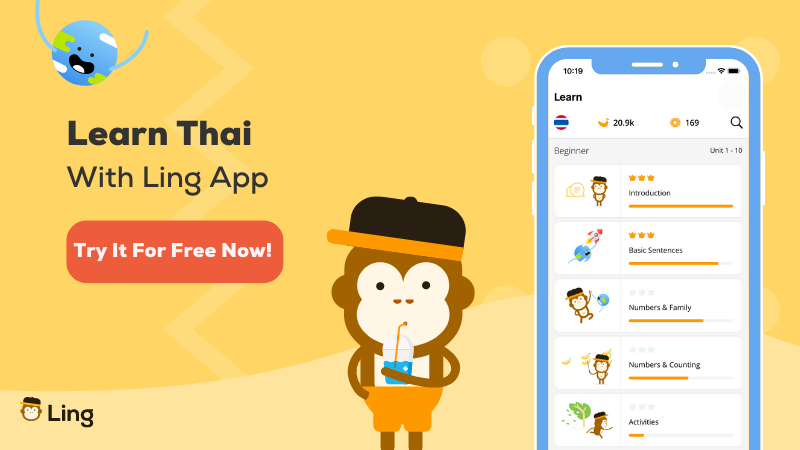Greetings, dear reader! Oh, wait a minute! I ought to say S̄wạs̄dī (สวัสดี) while simultaneously folding my hands in one of the most fundamental Thai hand gestures of Wai (H̄ịŵ – ไหว้). So, Swaasdee, dear reader, to another Thai language learning blog!
Have you ever heard the phrase “actions speak louder than words”? This idiom is especially relevant when it comes to nonverbal communication. In fact, it can sometimes convey more meaning than words ever could. One form of nonverbal communication that is prevalent in many cultures is the use of hand gestures. So, let’s read further and learn how fundamental that is in the vibrant culture of Thailand.
The Power Of A Thai Wai
I experienced body language’s power when I visited Thailand a few years ago. Unlike the West or other countries where we shake hands to greet someone, the scenario in Thailand was quite different. Upon arrival, and thereafter at every pit and stop, I was greeted with the Thai greeting of S̄wạs̄dī along with a Wai gesture, which involves placing your palms together in front of your chest and performing a slight bow with your head.
If you’ll ask me, this gesture is similar to the Namaste gesture commonly used here in India. As an Indian native, I could immediately relate to the message and tradition behind the gesture. No wonder I would return the greeting enthusiastically!
It’s fascinating to learn that Thai people tend to use a lot of nonverbal communication in the form of body language, head nod, and facial expressions. In fact, these nonverbal forms of communication are so ingrained in the culture of Asian countries that it’s almost impossible to communicate effectively without them.

Thai People And Their Body Language
In Thailand, the Wai gesture is used to say hello, thank you, goodbye, or to render an apology. Thai people generally use it to show respect to elders, monks, or people of higher standing. In addition, the height at which the hands are held during Wai can convey different levels of respect or formality. For example, when greeting someone of higher social status, the hands are held higher up than when greeting a friend or family member.
Another commonly used Thai hand sign is the ‘thumbs up.’ Unlike in Western cultures, where a ‘thumbs up’ is generally a sign of approval or a nod of encouragement, Thai tradition can mean different things depending on the context. In Thailand, for example, ‘thumbs up’ can be used as an ok sign, but it can also be considered rude in certain situations.
In addition to hand gestures, the head nod is commonly used in Southeast Asia and the Indian subcontinent. The head nod, which involves tilting the head from side to side, can convey various emotions or meanings, including agreement, confusion, or uncertainty. For those unfamiliar with the gesture, it is not easy to decipher the intended message.
Thai Hand Gestures & Meanings
As we discussed earlier, hand gestures are an essential part of communication in Thailand, and mastering them can help you connect with the locals and navigate social situations more effectively. Let’s take a look at some of those below.

#1 Wai
As mentioned, Wai involves placing your palms together in front of your chest and performing a bow with your head. The gesture is used as a greeting, a sign of respect, and a polite way of saying thank you. The height at which you hold your hands is also important, as it can convey different levels of respect or formality.
#2 Sai Sin
Another meaningful hand gesture among the Thai people is Sai sin. It involves tying a sacred string around the wrist of another person, usually during a religious ceremony or auspicious occasion. The string is believed to bring good luck and ward off evil spirits, and to wear it is considered a sign of respect for tradition and culture.
#3 Ram Muay
If you want to express your gratitude or appreciation for someone in Thailand, Ram muay is a great way to do it. It involves clasping your hands together, bringing them to your forehead, and bowing slightly. The gesture is often used in martial arts but can also be used as a sign of respect or to express gratitude, even in everyday situations.

#4 Yai
If you’re looking for directions, the Yai is a great way to ask for help. It involves holding your hand up with your fingers pointed in the direction you want to go.
#5 Mong
If you want to show someone that you’re thinking deeply about something, Mong is a great way to do it. It involves placing your index finger on your forehead and closing your eyes. The gesture is often used in meditation but can also indicate deep thought or contemplation.
Thai Facial Expressions
Now, let’s talk about other forms of body language and nonverbal communication in Thailand. Facial expressions are an important part of nonverbal communication, and Thai people are known for being quite expressive with their faces. For example, if someone wrinkles their nose, it can signify disgust or disapproval. On the other hand, smiling can indicate friendliness, happiness, or a desire to please others.
Thai body language is also an essential part of communication in Thai culture. If someone tilts their head to one side, it can indicate confusion or uncertainty. If someone touches their chest, it can be a sign of sincerity or honesty. And if someone touches their nose or mouth, it can be a sign of shyness or embarrassment.

Dos & Donts Of Thai Gestures In Thailand
Now that we’ve covered the different hand gestures, facial expressions, and body language used in Thai culture, let’s talk about some dos and don’ts of nonverbal communication as a visitor in Thailand.
While hand gestures and nonverbal communication can be incredibly useful for cross-cultural communication, they can also be a source of confusion and misunderstandings. For example, a hand gesture that is perfectly acceptable in one culture may be considered offensive in another. In Thailand, for example, pointing with your feet or touching someone’s head is considered disrespectful, while in India, showing the soles of your feet or shoes is also considered disrespectful.
First, it’s important to remember that Wai is a sign of respect, and you should always return it when someone performs it for you. However, it would be best if you also were mindful of the height at which you hold your hands, as holding your hands higher than someone of higher social status can be seen as disrespectful.
In addition, you should avoid touching someone’s head or pointing your feet at them, as both actions are considered disrespectful in Thai culture. You should also avoid using aggressive or confrontational body language.
Want To Learn Some More Thai?
Nonverbal communication plays a significant role in communication without barriers. They are powerful tools that can help us connect with people from different cultures and convey complex emotions. When I visited the country of Thailand, I was amazed at how much I could communicate without speaking much Thai.
However, it’s important to remember that not all gestures and nonverbal communication are universal, and we should always be mindful of cultural differences when communicating with people from different backgrounds. Our advice? It will help if you have some basic Thai phrases in your pocket to help you get by.

Give A Shot At Learning Thai With Ling!
The Ling app brings together advanced tools and engaging techniques for easy language learning through a variety of its features – a gamified interface, interactive exercises, and fun quizzes. What’s more, not only can you speak & write Thai, but you can also learn 60 more languages with its help. I am sure you won’t be looking back once you get hooked on this app! So, go to your Play Store or App Store to download the Ling app for free now!





















